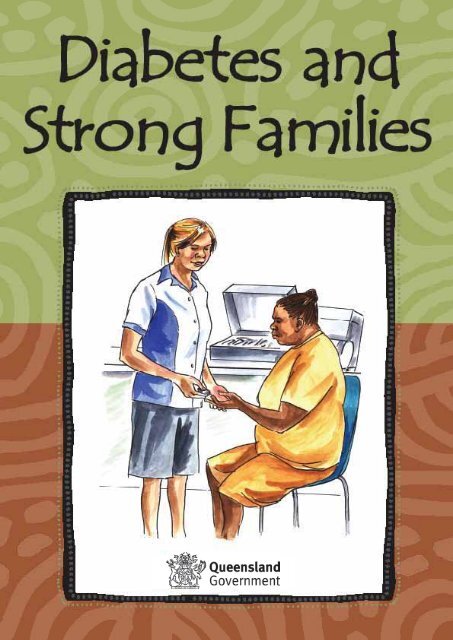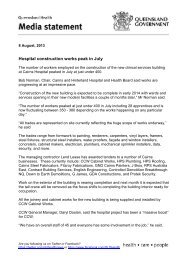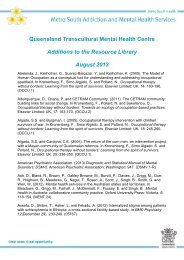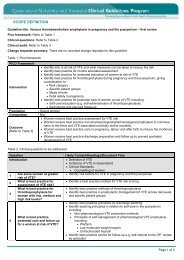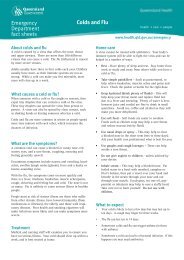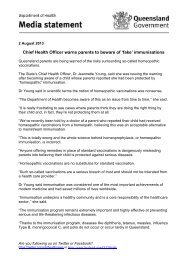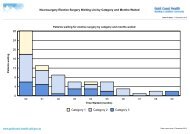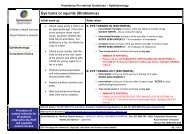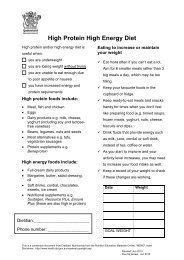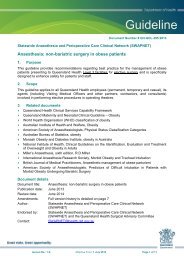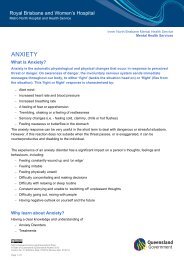Diabetes and Strong Families - Queensland Health - Queensland ...
Diabetes and Strong Families - Queensland Health - Queensland ...
Diabetes and Strong Families - Queensland Health - Queensland ...
Create successful ePaper yourself
Turn your PDF publications into a flip-book with our unique Google optimized e-Paper software.
The Queensl<strong>and</strong> Government supports <strong>and</strong> encourages the dissemination <strong>and</strong> exchange<br />
of information.<br />
However, copyright protects this material. The State of Queensl<strong>and</strong> has no objection to<br />
this material being reproduced made available online or electronically, but only if it is<br />
recognised as the owner <strong>and</strong> this material remains unaltered. Inquiries to adapt this<br />
material should be addressed by email to: ip_officer@health.qld.gov.au or by mail to:<br />
The IP Officer, Purchasing <strong>and</strong> Logistics Unit, Queensl<strong>and</strong> <strong>Health</strong>, GPO Box 48,<br />
BRISBANE 4001.<br />
©The State of Queensl<strong>and</strong> (Queensl<strong>and</strong> <strong>Health</strong>) 2008<br />
2
Editors:<br />
Gavin Broomhead, Senior Public Affairs Officer, Tropical Population <strong>Health</strong> Services<br />
Tanya Stiles, Nutrition Promotion Officer (ATSIH), Tropical Population <strong>Health</strong> Services<br />
Contributors:<br />
Meg Adam, Acting Director Public <strong>Health</strong> Nutrition, Tropical Population <strong>Health</strong> Services<br />
Kym Blechynden, Acting Senior Public <strong>Health</strong> Nutritionist, Tropical Population <strong>Health</strong> Services<br />
Stephanie Capuzzi, Administration Officer, Tropical Population <strong>Health</strong> Services<br />
Maureen Chamberlain, Nutrition Promotion Officer (ATSIH), Central Population <strong>Health</strong> Services<br />
Dawn Charteris, Nutrition Promotion Officer (ATSIH), Tropical Population <strong>Health</strong> Services<br />
Margaret Daly, Acting Senior Public <strong>Health</strong> Nutritionist, Tropical Population <strong>Health</strong> Services<br />
Caroline Giles, Acting Public <strong>Health</strong> Nutritionist, Tropical Population <strong>Health</strong> Services<br />
Tonya Grant, Senior <strong>Health</strong> Promotion Officer (Indigenous <strong>Health</strong>),<br />
Tropical Population <strong>Health</strong> Services<br />
Georgia Green, Zonal Coordinator, School Based Youth <strong>Health</strong> Nurse,<br />
Tropical Population <strong>Health</strong> Services<br />
Florence Henaway, Advanced <strong>Health</strong> Worker, Townsville Sexual <strong>Health</strong> Unit<br />
Kim Johnson, Senior Administration Officer, Tropical Population <strong>Health</strong> Services<br />
Sue Matthews, Administration Officer, Tropical Population <strong>Health</strong> Services<br />
Patricia Rose, Advanced <strong>Health</strong> Worker (Nutrition Promotion), Tropical Population <strong>Health</strong> Services<br />
Graphic design <strong>and</strong> layout:<br />
Stacey Lomax<br />
Illustrations:<br />
Julie Haysom<br />
Acknowledgements:<br />
A big thank you for the wonderful assistance from the Aboriginal <strong>and</strong> Torres Strait Isl<strong>and</strong>er<br />
community members’ <strong>and</strong> health professionals throughout North Queensl<strong>and</strong> <strong>and</strong> the Torres Strait<br />
Isl<strong>and</strong>s who attended focus groups <strong>and</strong> offered their input <strong>and</strong> recommendations to this version of<br />
<strong>Diabetes</strong> <strong>and</strong> <strong>Strong</strong> <strong>Families</strong>.<br />
<strong>Health</strong> professionals who completed the Nutrition Resource Review in 2007.<br />
Contributors to the 1997 <strong>and</strong> 2002 versions of What is <strong>Diabetes</strong>?<br />
Participants of the competition which has led to the new name <strong>Diabetes</strong> <strong>and</strong> <strong>Strong</strong> <strong>Families</strong>.<br />
Colleagues in the Tropical Population <strong>Health</strong> Services who have actively contributed to this<br />
resource development.<br />
3
Components of this resource have been adapted from the following:<br />
• Aboriginal <strong>and</strong> Torres Strait Isl<strong>and</strong>er Nutrition <strong>and</strong> Physical Activity Brief Intervention<br />
Program, Tropical Population <strong>Health</strong> Services (TPHS), 2008<br />
• Living <strong>Strong</strong> – A healthy lifestyle program for Aboriginal <strong>and</strong> Torres Strait Isl<strong>and</strong>er<br />
communities, Queensl<strong>and</strong> <strong>Health</strong>, 2008<br />
• <strong>Health</strong>y Murries, <strong>Strong</strong> Hearts, Third Edition 2007, Southern Area Population<br />
<strong>Health</strong> Services<br />
• The Aboriginal <strong>and</strong> Torres Strait Isl<strong>and</strong>er Guide to <strong>Health</strong>y Eating adapted from the<br />
Australian Guide to <strong>Health</strong>y Eating (AGTHE) by the Department of <strong>Health</strong> <strong>and</strong><br />
Community Services, Northern Territory<br />
• <strong>Diabetes</strong> Management in General Practice, The Royal Australian College of General<br />
Practitioners <strong>and</strong> <strong>Diabetes</strong> Australia, 2008/9<br />
• The Canning Stock Route Challenge “Beat Type 2 diabetes” Adapted, with<br />
permission, from the Canning Stock Route Challenge flipchart. Original concept - Stephen<br />
Vigh; artwork Red Logic Design; funding - <strong>Health</strong>way. WACHS - Pilbara, Kimberley<br />
<strong>and</strong> Gascoyne Population <strong>Health</strong> Units.<br />
Background<br />
<strong>Diabetes</strong> <strong>and</strong> <strong>Strong</strong> <strong>Families</strong> was previously known as What is <strong>Diabetes</strong>? A revised <strong>and</strong><br />
renamed version was developed in 2008 following a TPHS evaluation conducted in 2007.<br />
<strong>Diabetes</strong> <strong>and</strong> <strong>Strong</strong> <strong>Families</strong> is a general information book for health professionals to<br />
use with Aboriginal <strong>and</strong> Torres Strait Isl<strong>and</strong>er clients. It is a book that can be h<strong>and</strong>ed out<br />
to clients <strong>and</strong> their families.<br />
<strong>Diabetes</strong> <strong>and</strong> <strong>Strong</strong> <strong>Families</strong> has been produced for general advice only. It does not<br />
take the place of regularly seeing your doctor <strong>and</strong>/or your health team for more<br />
information <strong>and</strong> regular health checks.<br />
<strong>Diabetes</strong> <strong>and</strong> <strong>Strong</strong> <strong>Families</strong> will be most useful when used together with the What<br />
to Eat book. What to Eat raises the awareness of the importance of healthy eating <strong>and</strong><br />
physical activity for people who want to be healthy, especially for people living with<br />
diabetes.<br />
4
Useful links <strong>and</strong> resources<br />
Queensl<strong>and</strong> <strong>Health</strong><br />
Information is available about healthy living, including nutrition, physical<br />
activity <strong>and</strong> food safety. www.health.qld.gov.au/healthieryou<br />
Australian Resource Centre for <strong>Health</strong>care Innovations (ARCHI)<br />
Website links to a range of diabetes resources.<br />
www.archi.net.au/e-library/service/chronic/chronic_resources/diabetes2<br />
Nutrition Australia – 07 3257 4393<br />
Contact for a range of nutrition information. www.nutritionaustralia.org<br />
National Heart Foundation- 1300 362 787<br />
Contact for brochures, catering <strong>and</strong> recipe ideas.<br />
www.heartfoundation.org.au<br />
Building a <strong>Health</strong>y, Active Australia www.healthyactive.gov.au<br />
Eat Well Be Active www.health.qld.gov.au/eatwellbeactive<br />
Go for 2 <strong>and</strong> 5 www.gofor2<strong>and</strong>5.com.au<br />
The Australian Guide to <strong>Health</strong>y Eating consumer’s booklet.<br />
1800 020 103<br />
Australian Government Department of <strong>Health</strong> <strong>and</strong> Ageing.<br />
www.nhmrc.gov.au/publications/synopses/dietsyn.htm<br />
The Canning Stock Route Challenge “Beat Type 2 diabetes” DVD<br />
Pilbara, Kimberley <strong>and</strong> Gascoyne Population <strong>Health</strong> Units.<br />
For copies of the DVD, contact Tropical Population <strong>Health</strong> Services<br />
– Townsville<br />
07 4753 9000<br />
Other programs<br />
Contact your community nutrition team or health centre for more information<br />
on healthy lifestyle programs in your local community.<br />
5
Contents<br />
Introduction .................................................................................................. 7<br />
Signs <strong>and</strong> symptoms ....................................................................................8<br />
Different types of diabetes ............................................................................9<br />
What is Type 2 diabetes? ............................................................................. 10<br />
The food journey <strong>and</strong> Type 2 diabetes ..........................................................11<br />
What is Type 1 diabetes? ............................................................................. 13<br />
Gestational diabetes ................................................................................... 14<br />
Sexual problems for women with diabetes ...................................................17<br />
Sexual problems for men with diabetes ...................................................... 18<br />
Regular health checks ................................................................................. 19<br />
<strong>Diabetes</strong> health checks ...............................................................................20<br />
Keeping diabetes under control at home .....................................................22<br />
Having a healthy body weight ..................................................................... 23<br />
The Aboriginal <strong>and</strong> Torres Strait Isl<strong>and</strong>er Guide to <strong>Health</strong>y Eating ................24<br />
Four tips to healthy eating ........................................................................... 25<br />
Looking after the heart ................................................................................26<br />
Fats in food ................................................................................................. 27<br />
Shopping hints ...........................................................................................28<br />
Being physically active every day ................................................................29<br />
Why it’s good to be physically active every day ............................................30<br />
Keeping the mind strong ............................................................................. 31<br />
Alcohol <strong>and</strong> diabetes .................................................................................. 32<br />
Smoking, drugs <strong>and</strong> diabetes ..................................................................... 33<br />
<strong>Diabetes</strong> check up ...................................................................................... 34<br />
Goals for management of diabetes ..............................................................36<br />
6
Introduction<br />
<strong>Diabetes</strong> <strong>and</strong> <strong>Strong</strong> <strong>Families</strong> has been developed to raise awareness of<br />
diabetes with a specific focus on Aboriginal <strong>and</strong> Torres Strait Isl<strong>and</strong>er people.<br />
<strong>Diabetes</strong> <strong>and</strong> <strong>Strong</strong> <strong>Families</strong> provides general information on diabetes <strong>and</strong><br />
the importance of healthy eating <strong>and</strong> physical activity. Some of the key<br />
messages are to:<br />
• Choose healthy food <strong>and</strong> drinks<br />
• Be more physically active<br />
• Avoid alcohol, drugs <strong>and</strong> smoking cigarettes<br />
• Look after your feet<br />
• Have your blood glucose levels checked regularly<br />
• Have your blood pressure <strong>and</strong> blood tests checked regularly<br />
• Have your eyes, teeth <strong>and</strong> kidneys checked regularly<br />
• Take your medication if necessary.<br />
If you <strong>and</strong> your family have a healthy lifestyle this will help:<br />
• Give protection from illness<br />
• Keep everyone strong, happy <strong>and</strong> healthy<br />
• Maintain a healthy weight.<br />
<strong>Diabetes</strong> <strong>and</strong> <strong>Strong</strong> <strong>Families</strong> can be used together with the What to Eat book.<br />
Being healthy is important for the whole family.<br />
7
Signs <strong>and</strong> symptoms<br />
Talk to your doctor or health professional if you have any of the following<br />
signs or symptoms:<br />
No energy, tired all the time<br />
Feeling thirsty more often<br />
Cuts, sores <strong>and</strong> rashes that heal slowly<br />
Needing to go to the toilet more often<br />
Some people with diabetes may not feel any different than usual.<br />
8
Different types of diabetes<br />
Type 2 diabetes<br />
• Can occur at any age, even during childhood<br />
• Insulin is not used properly in the muscles, liver <strong>and</strong> fat cells, or the body<br />
cannot make enough insulin.<br />
Type 1 diabetes<br />
• The body no longer makes any insulin<br />
• Is more common in children or young<br />
adults.<br />
Gestational diabetes<br />
• Occurs during pregnancy<br />
• Develops when the body doesn’t use insulin<br />
properly<br />
• Usually goes away after the baby is born<br />
• Increases the risk of having<br />
Type 2 diabetes later<br />
in life for mum <strong>and</strong> baby.<br />
Pre-diabetes<br />
• The blood glucose level is higher than normal,<br />
but not high enough to be diagnosed as diabetes<br />
• You are at risk of getting Type 2 diabetes <strong>and</strong> heart<br />
disease<br />
• The blood glucose level could return to normal by<br />
losing weight, getting physically active <strong>and</strong> having<br />
healthy food <strong>and</strong> drinks.<br />
9
What is Type 2 diabetes?<br />
Type 2 diabetes is the most common form of diabetes.<br />
People with Type 2 diabetes often have high blood pressure, high cholesterol<br />
<strong>and</strong> an apple-shaped body. An apple-shaped body is when there is too much<br />
weight around the belly.<br />
Type 2 diabetes is usually found in<br />
adults, but more children, especially<br />
those who are overweight or obese,<br />
are now developing Type 2 diabetes.<br />
People with Type 2 diabetes make insulin,<br />
but this insulin does not work properly.<br />
This makes it hard for the blood glucose<br />
level to be normal, which means the blood<br />
glucose level will be high.<br />
10
The food journey <strong>and</strong> Type 2 diabetes<br />
Glucose is<br />
carried by the blood<br />
through the body.<br />
Food is broken<br />
down in the<br />
stomach into<br />
glucose.<br />
Blood carries the glucose to the<br />
pancreas. When glucose<br />
gets to the pancreas,<br />
Insulin Man comes<br />
out to work.<br />
11<br />
Glucose<br />
Blood
Insulin Man unlocks the cells with his<br />
key to let the glucose enter the cells.<br />
This gives the cells energy.<br />
Locked Cell Open Cell<br />
Adapted, with permission, from the Canning Stock Route Challenge flipchart. Original concept - Stephen Vigh; artwork<br />
Red Logic Design; funding - <strong>Health</strong>way. WACHS - Pilbara, Kimberley <strong>and</strong> Gascoyne Population <strong>Health</strong> Units.<br />
Some people may have Type 2 diabetes for many years<br />
without knowing it.<br />
12<br />
With Type 2 diabetes, too many<br />
fat cells can stop Insulin Man<br />
from doing his job properly, so<br />
the glucose stays in the blood.<br />
Fat Cell<br />
The glucose in the blood starts to build up to a high level. When the glucose<br />
in the blood gets too high, it starts to damage the body.
What is Type 1 diabetes?<br />
Without Insulin Man <strong>and</strong> his key, the<br />
cells can't be unlocked <strong>and</strong> the glucose<br />
cannot enter the muscles <strong>and</strong> other<br />
body cells.<br />
Living with Type 1 diabetes involves:<br />
• Insulin injections<br />
• Regular healthy eating<br />
• Gentle to moderate physical activity.<br />
People with Type 1 diabetes need<br />
insulin injections every day.<br />
The pancreas no longer makes insulin.<br />
This means there is no Insulin Man.<br />
The start of Type 1 diabetes is<br />
usually sudden because the glucose<br />
has built up very quickly in the blood.<br />
The glucose stays in the blood <strong>and</strong><br />
causes damage to the body.<br />
Ask the doctor or health professional for more<br />
information about Type 1 diabetes.<br />
13
Gestational diabetes<br />
Gestational diabetes develops in some women during pregnancy.<br />
It is important to have regular checks with the doctor if the mum is at risk of<br />
gestational diabetes.<br />
<strong>Diabetes</strong> during pregnancy can cause problems for the mum <strong>and</strong> baby.<br />
Gestational diabetes is more common in women who:<br />
Have a family history of Type 2 diabetes<br />
Have had gestational diabetes during pregnancy before<br />
Are overweight<br />
Have given birth to a large baby<br />
Are Aboriginal or Torres Strait Isl<strong>and</strong>er<br />
Have had difficulty carrying a previous baby to full term.<br />
All pregnant women need to have regular check ups.<br />
14
Gestational diabetes<br />
Uncontrolled blood glucose levels<br />
can make the mum feel tired, sick<br />
in the belly, dizzy, dry in the mouth<br />
<strong>and</strong> feel unwell.<br />
15<br />
Good blood glucose levels<br />
during pregnancy helps the baby<br />
to be born strong <strong>and</strong> grow into a<br />
healthy adult.<br />
Gestational diabetes can cause some<br />
babies to grow too big, which can make the<br />
baby unwell.<br />
A mum who has Gestational diabetes when she is pregnant is more<br />
likely to develop diabetes later in life. The baby is also more likely to<br />
develop diabetes as they get older.<br />
It is important for mum to take care of her diabetes while she is<br />
pregnant. <strong>Health</strong>y Mum = <strong>Health</strong>y Baby = <strong>Health</strong>y Adult.
Gestational diabetes<br />
Eat regularly throughout the day<br />
Say NO to alcohol, smoking <strong>and</strong> other drugs<br />
Breastfeeding helps to prevent baby from<br />
getting diabetes later in life.<br />
Breastfeeding will also help the mum to<br />
stay at a healthy weight. This may help<br />
delay or stop the diabetes coming back.<br />
16<br />
Drink lots of water<br />
Keep active
Sexual problems for women with diabetes<br />
Some women may need to have their blood glucose levels checked more<br />
often during the menstrual cycle (periods). If they are on insulin or<br />
medication, then the doctor may need to adjust the doses at this time.<br />
• Sometimes sexual intercourse can cause the blood glucose level to drop.<br />
Test your blood glucose level before having sexual intercourse<br />
• Women may have problems with their arousal, sex drive (libido) <strong>and</strong><br />
vaginal dryness, because of the nerve damage caused by diabetes<br />
• Some women with diabetes may also be prone to thrush (c<strong>and</strong>idiasis)<br />
• If some women do have thrush, they need to make sure their partner<br />
receives treatment at the same time. These things can be sorted out at the<br />
local health service.<br />
Don’t feel shame, talk to the doctor or health professional.<br />
They can help <strong>and</strong> will have talked with many other women<br />
who are having the same problems.<br />
17
Sexual problems for men with diabetes<br />
Some men with diabetes may experience sexual health problems. High blood<br />
pressure <strong>and</strong> diabetes increases the risk of blood vessel damage, which may<br />
reduce circulation to the penis.<br />
Men need to look after themselves <strong>and</strong> their diabetes, as this will help to look<br />
after their sex drive. They should try to have something to eat just before or<br />
right after having sexual intercourse, as the physical activity of sex can cause<br />
their blood glucose level to drop.<br />
Don’t feel shame, talk to the doctor or health<br />
professional. They can help <strong>and</strong> will have talked with<br />
many other men who are having the same problems.<br />
18
Regular health checks<br />
It is important to have regular check ups at the health clinic.<br />
Waist<br />
measurements<br />
Blood glucose level (BGL) test<br />
This is done by a finger prick with a sharp<br />
needle to get a drop of blood. This drop<br />
of blood is placed on a test strip <strong>and</strong> put<br />
into a machine that gives a BGL reading.<br />
Blood pressure<br />
19<br />
Height <strong>and</strong><br />
weight<br />
measurements<br />
Blood cholesterol level<br />
This is a fasting blood test.
<strong>Diabetes</strong> health checks<br />
These are extra checks that are needed when a person has diabetes.<br />
Eyes<br />
An eye check to see if there is any<br />
damage caused by uncontrolled<br />
blood glucose levels.<br />
Kidneys<br />
A urine test will tell if the<br />
kidneys are working properly.<br />
20<br />
Teeth<br />
A dental check for<br />
gum disease.
<strong>Diabetes</strong> health checks<br />
HbA1c<br />
This shows the blood<br />
glucose levels over the<br />
last three months.<br />
Feet will be checked for :<br />
• Cuts or sores that don’t heal <strong>and</strong> may get infected<br />
• Numbness in the feet<br />
• Any changes to blood flow.<br />
Take control don't be afraid to ask questions.<br />
21
Keeping diabetes under control at home<br />
It is important to check blood glucose<br />
levels at home. Talk to a health<br />
professional about the equipment<br />
needed to do this.<br />
Some people with Type 2<br />
diabetes need to have<br />
injections every day. These<br />
people need to talk to a<br />
<strong>Diabetes</strong> Educator about<br />
when they eat, <strong>and</strong> being<br />
physically active.<br />
Some people with Type 2 diabetes need to<br />
take medication every day. These people still<br />
need to have healthy foods <strong>and</strong> drinks <strong>and</strong> be<br />
physically active.<br />
Feet checks are important to do at home every day.<br />
22
Having a healthy body weight<br />
<strong>Diabetes</strong> can be prevented by having a healthy body weight.<br />
Losing weight, especially fat from around the belly, will help lower glucose<br />
levels from the blood.<br />
Having healthy foods <strong>and</strong> drinks <strong>and</strong> being physically active will help us to<br />
stay healthy.<br />
It’s important to talk to a health professional<br />
before starting any physical activity.<br />
23
The Aboriginal <strong>and</strong> Torres Strait Isl<strong>and</strong>er<br />
Guide to <strong>Health</strong>y Eating<br />
To stay healthy <strong>and</strong> active we need to eat a wide variety of healthy foods <strong>and</strong><br />
drinks. These can be traditional foods or foods from the store or supermarket.<br />
The Aboriginal <strong>and</strong> Torres Strait Isl<strong>and</strong>er Guide to <strong>Health</strong>y Eating gives us an<br />
idea of what foods <strong>and</strong> drinks to have more or less of over the day.<br />
The guide has three key messages:<br />
.<br />
The Aboriginal <strong>and</strong> Torres Strait Isl<strong>and</strong>er Guide to <strong>Health</strong>y Eating used with permission from the Department of <strong>Health</strong> <strong>and</strong><br />
Community Services, Northern Territory.<br />
24<br />
Variety<br />
- The ‘plate’ shows<br />
the food we need<br />
every day from the<br />
five food groups to<br />
stay healthy.<br />
Water<br />
- It’s important<br />
to drink plenty of<br />
water every day.<br />
Extras<br />
- Are high in fat<br />
<strong>and</strong>/or sugar <strong>and</strong><br />
should only be<br />
eaten in small<br />
amounts.
Four tips to healthy eating<br />
1. Drink more water 2. Cut out sugary drinks<br />
3. Eat some vegetables <strong>and</strong> fruit everyday, including bush tucker<br />
varieties<br />
4. Eat less fatty food <strong>and</strong> fried food<br />
25
Looking after the heart<br />
Blood moves around the body through the blood vessels.<br />
It is normal to have some fats in the blood, but some people can have<br />
too much.<br />
There are different types of fats in the blood. The bad fats that can<br />
damage the heart are:<br />
Cholesterol <strong>and</strong><br />
Triglycerides<br />
Having these fats in the blood can lead to blocked blood vessels.<br />
Blood will not move through these blocked vessels easily.<br />
Blocked blood vessels can cause heart disease <strong>and</strong> strokes.<br />
Having blood cholesterol <strong>and</strong> triglyceride levels checked<br />
is very important.<br />
26
Fats in food<br />
There are different types of fat in food. These fats are called saturated,<br />
polyunsaturated <strong>and</strong> monounsaturated.<br />
Saturated fat is the type of fat that raises blood cholesterol <strong>and</strong><br />
increases the risk of heart disease.<br />
Saturated fats are found in foods such as:<br />
• Deep fried takeaways<br />
• Potato crisps <strong>and</strong> fries<br />
• Biscuits<br />
• Pastries<br />
• Chocolate<br />
• Coconut (the flesh).<br />
Saturated fats can harm the heart.<br />
Polyunsaturated fat is a better type of fat, but should still only be used in<br />
small amounts.<br />
Polyunsaturated fats are found mostly in:<br />
• Plant foods such as walnuts, brazil nuts <strong>and</strong> seeds<br />
• Some fish such as salmon, mackerel, tuna <strong>and</strong> canned sardines<br />
• Margarines <strong>and</strong> oils such as sunflower, safflower <strong>and</strong> soybean.<br />
Monounsaturated fat should also only be used in small amounts.<br />
Monounsaturated fats are found in:<br />
• Margarines <strong>and</strong> oils such as canola, peanut <strong>and</strong> olive oil<br />
• Plant foods such as avocados, peanuts, hazelnuts <strong>and</strong> almonds.<br />
It is important to cut back on high fat foods.<br />
27
Shopping hints<br />
<strong>Health</strong>y Shopping List<br />
Breakfast cereal (low fat / high fibre)<br />
Bread (wholemeal, wholegrain, pita, lebanese)<br />
Crackers / crispbread (low fat / high fibre)<br />
Pasta, rice, noodles (wholemeal)<br />
Vegetables (fresh, frozen, green leafy, yellow,<br />
orange, salad)<br />
Fruit (not fruit juice)<br />
Milk (low fat, fresh or UHT, or powdered skim)<br />
Yoghurt (low fat flavoured or natural)<br />
Ice-cream (low fat, low sugar)<br />
Cheese (cottage, ricotta, low fat hard cheese)<br />
Lean red meat, chicken, turkey<br />
Fish (fresh, tinned, frozen fillets)<br />
Beans <strong>and</strong> lentils (dried or tinned, baked beans,<br />
kidney beans, chickpeas)<br />
Margarine (mono or poly – unsaturated)<br />
Olive oil, canola oil<br />
Tomato based pasta sauce<br />
Tinned tomatoes, tomato paste<br />
Eggs<br />
Powdered coconut milk, light coconut milk<br />
• Remember that money can be saved by not buying junk food<br />
• Remember buying cigarettes <strong>and</strong> alcohol will leave less money<br />
to buy healthy food.<br />
28
Being physically active every day<br />
Physical activity helps:<br />
• To lose weight <strong>and</strong> keep it off<br />
• To keep blood glucose levels,<br />
blood pressure <strong>and</strong> cholesterol<br />
levels under control<br />
• The body use insulin better<br />
• Prevent stroke <strong>and</strong> heart disease<br />
• To keep people healthy.<br />
Just 30 minutes a day, or three lots of 10 minutes is all that is<br />
needed to stay healthy.<br />
To be physically active safely:<br />
• Start slowly (don’t overdo it)<br />
• Drink water<br />
• Wear a hat <strong>and</strong> use sunscreen<br />
• Wear comfortable, enclosed shoes<br />
<strong>and</strong> socks.<br />
Talk to a health professional before starting any<br />
physical activity.<br />
29
Why it’s good to be physically active every<br />
day<br />
The body uses the glucose in the muscles as fuel to do things like work, play<br />
sport, walk, swim, fish or hunt.<br />
The more physically active people are,<br />
the healthier they will become.<br />
30
Keeping the mind strong<br />
Staying physically active helps to cope with stress <strong>and</strong> feel good inside.<br />
It’s important for every one to have some ‘ME’ time, especially those<br />
with diabetes. This can be as easy as:<br />
• Listening to music <strong>and</strong> dancing<br />
• Putting your feet up <strong>and</strong> rest in a quiet place<br />
• Reading a magazine, doing a crossword puzzle<br />
• Going for a walk<br />
• Joining a local club.<br />
Talk to a local mental health professional for information on<br />
keeping a healthy mind.<br />
31
Alcohol <strong>and</strong> diabetes<br />
Drinking alcohol is DANGEROUS for diabetics, especially if taking medication.<br />
It's important to cut down or say NO to alcohol.<br />
Alcohol is high in sugar, which can cause blood glucose levels to rise.<br />
Alcohol can also cause weight gain.<br />
4 litre wine cooler contains<br />
55 to 65 teaspoons of sugar<br />
1 can (375ml) premixed alcohol <strong>and</strong> softdrink contains<br />
7 1/2 teaspoons of sugar<br />
Talk to the local ATODS (Alcohol, Tobacco <strong>and</strong> Other Drugs<br />
Service) for more information.<br />
32
Smoking, drugs <strong>and</strong> diabetes<br />
One smoke with<br />
my drink won’t<br />
hurt.<br />
I don’t care about my diabetes.<br />
I just wanna drink <strong>and</strong> have a<br />
good time.<br />
I’ll deal with it later.<br />
Smoking decreases blood circulation which is worse for people with<br />
diabetes. Damage can be done to the body from smoking. This is why it’s<br />
important to think about giving up or cutting down.<br />
33<br />
Man! I feel like<br />
greasy food. I feel too<br />
slack to move.<br />
Talk to a health professional about stress <strong>and</strong> worry, or about<br />
how to quit smoking.
<strong>Diabetes</strong> check up<br />
The doctor or health professional should arrange the following list of health<br />
checks. The doctor can also arrange a referral for the Eye Specialist, Dietitian,<br />
<strong>Diabetes</strong> Educator <strong>and</strong> Podiatrist.<br />
Every 3 months<br />
Have your blood<br />
pressure checked<br />
at the clinic<br />
Every 3 – 6<br />
months<br />
HbA1c<br />
(blood test)<br />
Everyday – Check your<br />
blood glucose (sugar)<br />
levels daily <strong>and</strong> keep a<br />
record<br />
Everyday – Check your<br />
feet for cuts, blisters,<br />
cracks, dry skin,<br />
callouses <strong>and</strong> corns<br />
Yearly -<br />
Kidney check<br />
blood <strong>and</strong><br />
urine test<br />
These recommendations are a guide only <strong>and</strong> should be<br />
discussed further with the doctor or health professional.<br />
34<br />
Yearly - Eye test with an<br />
Eye Specialist<br />
Yearly – Dentist visit<br />
Yearly – Influenza<br />
(flu) needle<br />
Pneumococcal needle<br />
(every 5 years)<br />
Yearly – Check your<br />
cholesterol (blood<br />
test) at the clinic<br />
Yearly- a check with a<br />
<strong>Diabetes</strong> Educator,<br />
Dietitian, Podiatrist or<br />
an Endocrinologist<br />
may be required<br />
Every 3 months -<br />
Check weight <strong>and</strong> waist<br />
measure
Goals for management of diabetes<br />
Fasting BGL 4-6 mmol/L<br />
HbA1c ≤ 7 %<br />
LDL-C ‹ 2.5 mmol/L*<br />
Cholesterol ‹ 4.0 mmol/L*<br />
HDL Cholesterol ≥ 1.0 mmol/L*<br />
Triglycerides ‹ 2 mmol/L*<br />
Blood Pressure ‹ 130/80**<br />
Body Mass Index ≤ 25kg/m2<br />
Waist circumference ‹ 94cm – Men<br />
‹ 80cm – Women<br />
Cigarette consumption Zero<br />
Alcohol intake ≤ 2 st<strong>and</strong>ard drinks (20g)/day (men)***<br />
≤ 2 st<strong>and</strong>ard drinks (20g)/day (women)***<br />
Physical activity At least 30 minutes of walking (or equivalent)<br />
5 or more days / week ( total ≥ 150 minutes /<br />
week).<br />
* National Heart Foundation Guidelines (2007).<br />
** NHMRC Evidence-based Guidelines for the Management of Type 2<br />
<strong>Diabetes</strong>, 2004.<br />
***NHMRC, Australian Guidelines to reduce health risks from drinking<br />
alcohol, 2009.<br />
Adaptation of these goals is derived from the <strong>Diabetes</strong> Management in<br />
General Practice 2008/9. Published each year by <strong>Diabetes</strong> Australia in<br />
conjunction with the Royal Australian College of General Practitioners.<br />
35
Are you at risk?<br />
Please tick items that are true for you. Then show this list to the doctor or<br />
health professional.<br />
I have a parent, brother or sister with diabetes or<br />
who have had diabetes<br />
My mum had gestational diabetes<br />
I am overweight<br />
My family background is Aboriginal <strong>and</strong>/or Isl<strong>and</strong>er<br />
I have had gestational diabetes when pregnant<br />
I have high blood pressure<br />
My cholesterol levels are high or higher than normal<br />
I am not physically active; I do physical activity less<br />
than three times a week.<br />
Look for these signs:<br />
Feeling more thirsty than normal<br />
Needing to go to the toilet more often<br />
Always feeling hungry<br />
Cuts or sores that heal slowly<br />
Gaining weight<br />
Unexplained weight loss<br />
Having headaches all the time<br />
Feeling more tired or run down<br />
Blurred vision<br />
Feeling dizzy sometimes<br />
Bleeding gums.<br />
NUT - 018


